Reliable Integration of Neural Network and Internet of Things for Forecasting, Controlling, and Monitoring of Experimental Building Management System
Abstract
1. Introduction
2. Related Works
- Implement an experimental BMS system based on IoT technology.
- Design a real IoT platform and dashboard using the Bylink dashboard and the ThingSpeak platform for BMS.
- Investigate a new integration of PLC, Arduino Mega 2560, and ESP8266 with each other that makes the system more reliable and efficient.
- Monitor the status of measurement sensors, such as an IR sensor, an ultrasonic sensor, a smoke sensor, and a temperature sensor.
- Using ANN, create a forecasting model based on data collected from the IoT system.
- Monitoring and control of sensors and loads using the Bylink mobile application.
- Control the operation of A/C, lighting systems, ventilation, and firefighting systems based on IoT technology.
- Save energy and decrease consumption by controlling the operation of the A/C and lighting systems.
- Design the architectural layout of the BMS with detailed drawings and suggest the FM200 system for the firefighting system.
- Demonstrate a report for all controlled and monitored values based on IoT.
3. Methodology
3.1. Programmable Logic Contaroller (PLC)
3.2. ThingSpeak Platform
3.3. Bylink Platform
3.4. Hardware Implementation
4. Building Management System (BMS)
- The heating, ventilation, and air-conditioning system “HVAC”: The BMS is linked to sensors for measuring temperature, pressure, and humidity in the exhaust and ducts. The alarm is activated if any of these parameters exceed predetermined levels.
- The technical system of steam: In cases where the quality of the product is at risk, the BMS should sound an alert if temperature and pressure in the piping system drop below the set values to clean the whole steam.
- Laminar flow units, central heat blowers, central fume collection, and a central vacuum system: The BMS keeps tabs on how well these systems are functioning, enabling prompt maintenance of any defective components. Alarms would sound if there was an unexpected failure, and the product could then be safeguarded as needed.
- Chilled water system: The BMS has the potential to oversee the chillers in a building, ensuring that coolant temperatures and water are properly managed and pumps are properly distributed throughout the distribution loop.
- Central heating: to ensure that hot water is distributed effectively throughout the building. The BMS can keep tabs on both the temperature and status of the pumps.
- Safety systems and firefighting: The recommended material in this paper is the FM200 system.
- The electrical monitoring system: The BMS can monitor the consumed power as well as the status of the main electrical sensors and switches.
Architecture of BMS System
5. Internet of Things (IoT)
6. Artificial Neural Network (ANN)
7. Results and Discussion
- Scenario 1: Monitoring and Control of Temperature and Humidity
- Scenario 2: Monitoring and Control of Lighting System
- Scenario 3: Monitoring and Control of Fire System
- Scenario 4: Forecasting of Temperature-based Artificial Neural Network (ANN)
8. Conclusions
Author Contributions
Funding
Institutional Review Board Statement
Informed Consent Statement
Data Availability Statement
Acknowledgments
Conflicts of Interest
References
- Villa, V.; Naticchia, B.; Bruno, G.; Aliev, K.; Piantanida, P.; Antonelli, D. IoT Open-Source Architecture for the Maintenance of Building Facilities. Appl. Sci. 2021, 11, 5374. [Google Scholar] [CrossRef]
- Lawal, K.; Rafsanjani, H.N. Trends, benefits, risks, and challenges of IoT implementation in residential and commercial buildings. Energy Built Environ. 2021, 3, 251–266. [Google Scholar] [CrossRef]
- Mataloto, B.; Ferreira, J.C.; Cruz, N. Full IoT Lora School Building Management System. arXiv 2019, arXiv:2019050206. [Google Scholar]
- Tragos, E.Z.; Foti, M.; Surligas, M.; Lambropoulos, G.; Pournaras, S.; Papadakis, S.; Angelakis, V. An IoT based intelligent building management system for ambient assisted living. In Proceedings of the IEEE International Conference on Communication Workshop (ICCW), London, UK, 8–12 June 2015; pp. 246–252. [Google Scholar]
- Elsisi, M.; Mahmoud, K.; Lehtonen, M.; Darwish, M.M. Reliable industry 4.0 based on machine learning and IOT for analyzing, monitoring, and securing smart meters. Sensors 2021, 21, 487. [Google Scholar] [CrossRef]
- Mataloto, B.; Calé, D.; Carimo, K.; Ferreira, J.C.; Resende, R. 3d iot system for environmental and energy consumption monitoring system. Sustainability 2021, 13, 1495. [Google Scholar] [CrossRef]
- Christopoulos, K.; Antonopoulos, C.; Voros, N.; Orfanoudakis, T. Building automation systems in the world of internet of things. In Components and Services for IoT Platforms; Springer: Cham, Switzerland, 2017; pp. 355–375. [Google Scholar]
- Ramelan, A.; Adriyanto, F.; Hermanu, B.A.C.; Ibrahim, M.H.; Saputro, J.S.; Setiawan, O. IoT based building energy monitoring and controlling system using LoRa modulation and MQTT protocol. In Proceedings of the IOP Conference Series: Materials Science and Engineering, Solo, Indonesia, 20 October 2020; Volume 1096, p. 012069. [Google Scholar]
- Kumar, A.; Sharma, S.; Goyal, N.; Singh, A.; Cheng, X.; Singh, P. Secure and energy-efficient smart building architecture with emerging technology IoT. Comput. Commun. 2021, 176, 207–217. [Google Scholar] [CrossRef]
- Elsisi, M.; Tran, M.Q.; Mahmoud, K.; Lehtonen, M.; Darwish, M.M. Deep learning-based industry 4.0 and internet of things towards effective energy management for smart buildings. Sensors 2021, 21, 1038. [Google Scholar] [CrossRef]
- Bouabdallaoui, Y.; Lafhaj, Z.; Yim, P.; Ducoulombier, L.; Bennadji, B. Predictive maintenance in building facilities: A machine learning-based approach. Sensors 2021, 21, 1044. [Google Scholar] [CrossRef]
- Penchalaiah, N.; Nelson Emmanuel, J.; Suraj Kamal, S.; Lakshmi Narayana, C.V. IoT Based Smart Farming Using Thingspeak and MATLAB. In ICCCE 2020; Springer: Singapore, 2021; pp. 1273–1295. [Google Scholar]
- Luo, X.J.; Oyedele, L.O. Forecasting building energy consumption: Adaptive long-short term memory neural networks driven by genetic algorithm. Adv. Eng. Inf. 2021, 50, 101357. [Google Scholar] [CrossRef]
- Elshaboury, N. Training adaptive neuro fuzzy inference system using genetic algorithms for predicting labor productivity. In Proceedings of the International Conference on Emerging Technology Trends in Internet of Things and Computing, Erbil, Iraq, 6–8 June 2021; Springer: Cham, Switzerland, 2022; pp. 324–334. [Google Scholar]
- Arsenovic, M.; Sladojevic, S.; Anderla, A.; Stefanovic, D. FaceTime—Deep learning based face recognition attendance system. In Proceedings of the IEEE 15th International symposium on intelligent systems and informatics (SISY), Subotica, Serbia, 14–16 September 2017; pp. 53–58. [Google Scholar]
- Karagöz, E.; Tecim, V. An Integrated Model and Application for Smart Building Systems with Artificial Intelligence. In The Impact of Artificial Intelligence on Governance, Economics and Finance; Springer: Singapore, 2022; Volume 2, pp. 15–40. [Google Scholar]
- Fredianelli, L.; Carpita, S.; Bernardini, M.; Del Pizzo, L.G.; Brocchi, F.; Bianco, F.; Licitra, G. Traffic flow detection using camera images and machine learning methods in ITS for noise map and action plan optimization. Sensors 2022, 22, 1929. [Google Scholar] [CrossRef]
- Van Thuy, N. Applications of IOTS, Internet Data, and Artificial Intelligence in Building Better Management Information System (MIS) in Banking Activities in Vietnam. In Advances in Computational Intelligence and Communication Technology; Springer: Singapore, 2022; pp. 195–201. [Google Scholar]
- Onwubiko, C.; Ouazzane, K. Challenges towards building an effective cyber security operations centre. arXiv 2022, arXiv:2202.03691. [Google Scholar] [CrossRef]
- Bersani, C.; Ruggiero, C.; Sacile, R.; Soussi, A.; Zero, E. Internet of Things Approaches for Monitoring and Control of Smart Greenhouses in Industry 4.0. Energies 2022, 15, 3834. [Google Scholar] [CrossRef]
- Flores, M.; Heredia, D.; Andrade, R.; Ibrahim, M. Smart Home IoT Network Risk Assessment Using Bayesian Networks. Entropy 2022, 24, 668. [Google Scholar] [CrossRef]
- Rajkumar, K.; Thejaswini, K.; Yuvashri, P. Automation of Sustainable Industrial Machine using PLC. J. Phys. Conf. Ser. 2021, 1979, 012049. [Google Scholar] [CrossRef]
- Prasetyo, Y.; Hidayatullah, N.; Artono, B.; Danu, S. Power Factor Correction Using Programmable Logic Control Based Rotary Method. J. Phys. Conf. Ser. 2021, 1845, 012045. [Google Scholar] [CrossRef]
- Thürer, M.; Li, S.S.; Qu, T. Digital Twin Architecture for Production Logistics: The Critical Role of Programmable Logic Controllers (PLCs). Procedia Comput. Sci. 2022, 200, 710–717. [Google Scholar] [CrossRef]
- Mellado, J.; Núñez, F. Design of an IoT-PLC: A containerized programmable logical controller for the industry 4.0. J. Ind. Inf. Integr. 2022, 25, 100250. [Google Scholar] [CrossRef]
- Li, X.; Lin, S.; Shan, K.; Han, Z.; Wang, S. A self-organization method for logic control of distributed building automation system. J. Build. Eng. 2022, 54, 104688. [Google Scholar] [CrossRef]
- Laayati, O.; Bouzi, M.; Chebak, A. Smart Energy Management System: Design of a Monitoring and Peak Load Forecasting System for an Experimental Open-Pit Mine. Appl. Syst. Innov. 2022, 5, 18. [Google Scholar] [CrossRef]
- Sarishma; Sushant, C.; Sumitra, S.; Vivudh, F. Smart Home Automation using ESP8266 and Internet of Things. In Proceedings of the 5th International Conference on Next Generation Computing Technologies, Dehradun, India, 20–21 December 2019. [Google Scholar]
- Bhagyashree, A.; Manasi, M. IoT based Smart Agriculture using Thingspeak. Int. J. Eng. Res. Technol. 2019, 8. [Google Scholar]
- Adeyemo, J.O.; Olugbara, O.O.; Adetiba, E. Development of a Prototype Smart City System for Refuse Disposal Management. Am. J. Mech. Ind. Eng. 2019, 4, 6–23. [Google Scholar] [CrossRef]
- Homera, D.; Mitul, S.; Madhuri, V.; Shyam, K. Smart Automated Home Application using IoT with Blynk App. In Proceedings of the International Conference on Inventive Communication and Computational Technologies, Coimbatore, India, 20–21 April 2018. [Google Scholar]
- Samson, D.; Salam, C.; Ibrahim, U.; Abdulmumini, Z. Simulation and Construction of a Solar Powered Smart Irrigation System Using Internet of Things (IoT), Blynk Mobile App. Asian J. Agric. Hortic. Res. 2022, 9, 136–147. [Google Scholar]
- Priyanka, S.; Abhishek, K.; Amit, K.; Manish, K.; Irfan, H. Smart Irrigation Monitoring System Using Blynk App. Int. J. Innov. Sci. Res. Technol. 2021, 6, 1353–1355. [Google Scholar]
- Kristombu, S.; Thilakarathna, S.; Shalitha, J.; Arashpour, M.; Sharafi, P.; Teodosio, B.; Shringi, A.; Mendis, P. Artificial intelligence and smart vision for building and construction 4.0: Machine and deep learning methods and applications. Autom. Constr. 2022, 141, 104440. [Google Scholar]
- Serrano, W. iBuilding: Artificial intelligence in intelligent buildings. Neural Comput. Appl. 2022, 34, 875–897. [Google Scholar] [CrossRef]
- Thangamani, A.; Ganeshb, L.; Tanikellac, A.; Prasad, M. Issues concerning IoT adoption for energy and comfort management in intelligent buildings in India. Intell. Build. Int. 2022, 14, 74–94. [Google Scholar] [CrossRef]
- Muhammad, U.M.; Daye, C.; Zeeshan; Hyunjoo, H.; Gyuyeob, J.; Kuan, C. A review of the applications of artificial intelligence and big data to buildings for energy-efficiency and a comfortable indoor living environment. Energy Build. 2019, 202, 109383. [Google Scholar]
- Vijayan, D.; Leema, S.; Arvindan, S.; Revathy, J.; Amuthadevi, C. Automation systems in smart buildings: A review. J. Ambient. Intell. Humaniz. Comput. 2020, 1–13. [Google Scholar] [CrossRef]
- di Foggia, G. Energy efficiency measures in buildings for achieving sustainable development goals. Heliyon 2018, 4, e00953. [Google Scholar] [CrossRef]
- de la Cruz-Lovera, C.; Perea-Moreno, A.-J.; de la Cruz-Fernández, J.-L.; Alvarez-Bermejo, J.A.; Manzano-Agugliaro, F. Worldwide Research on Energy Efficiency and Sustainability in Public Buildings. Sustainability 2017, 9, 1294. [Google Scholar] [CrossRef]
- Lavanya, P.; Subbareddy, I.V. A comprehensive review on LoRa implementation in IoT application domains. In AIP Conference Proceedings; Villa, V., Ed.; AIP Publishing LLC: New York City, NY, USA, 2022; Volume 2516, p. 140001. [Google Scholar]
- Rastegari, H.; Nadi, F.; Lam, S.S.; Abdullah, M.I.; Kasan, N.A.; Rahmat, R.F.; Mahari, W.A.W. Internet of Things in aquaculture: A review of the challenges and potential solutions based on current and future trends. Smart Agric. Technol. 2023, 4, 100187. [Google Scholar] [CrossRef]
- Lee, I.; Lee, K. The Internet of Things (IoT): Applications, investments, and challenges for enterprises. Bus. Horiz. 2015, 58, 431–440. [Google Scholar] [CrossRef]
- Kaixin, L.; Jie, Z.; Jintao, H.; Ying, C. Dynamic energy efficient task offloading and resource allocation for NOMA-enabled IoT in smart buildings and environment. Build. Environ. 2022, 226, 109513. [Google Scholar] [CrossRef]
- Mengda, J.; Ali, K.; Yueren, W.; Ravi, S. Adopting Internet of Things for the development of smart buildings: A review of enabling technologies and applications. Autom. Constr. 2019, 101, 111–126. [Google Scholar]
- Roberto, C.; Angel, M.; Soffiene, A.; Javier, P.; Juan, M. IoT network slicing on virtual layers of homogeneous data for improved algorithm operation in smart buildings. Future Gener. Comput. Syst. 2020, 102, 965–977. [Google Scholar]
- Abdul, S.; Haidawati, N.; Muhammad, F.; Adidah, L.; Asadullah, S. A Review on Energy Consumption Optimization Techniques in IoT Based Smart Building Environments. Information 2019, 10, 108. [Google Scholar]
- Xiangyu, Z.; Manisa, P.; Tao, C.; Saifur, R. An IoT-Based Thermal Model Learning Framework for Smart Buildings. IEEE Internet Things J. 2019, 7, 518–527. [Google Scholar]
- Tabari, H.; Hosseinzadeh Talaee, P.; Willems, P. Short-term forecasting of soil temperature using artificial neural network. Meteorol. Appl. 2015, 22, 576–585. [Google Scholar] [CrossRef]
- Jiang, Z.; Ehmann, K.F.; Cao, J. Prediction of forming temperature in electrically-assisted double-sided incremental forming using a neural network. J. Mater. Process. Technol. 2022, 302, 117486. [Google Scholar] [CrossRef]
- Puri, V.; Kumar, N. Wind energy forecasting using artificial neural network in Himalayan region. Model. Earth Syst. Environ. 2022, 8, 59–68. [Google Scholar] [CrossRef]
- Ahmad, M.; Al Mehedi, M.A.; Yazdan, M.M.S.; Kumar, R. Development of Machine Learning Flood Model Using Artificial Neural Network (ANN) at Var River. Liquids 2022, 2, 147–160. [Google Scholar] [CrossRef]
- Pravallika, M.S.; Vasavi, S.; Vighneshwar, S.P. Prediction of temperature anomaly in Indian Ocean based on autoregressive long short-term memory neural network. Neural Comput. Appl. 2022, 34, 7537–7545. [Google Scholar] [CrossRef]
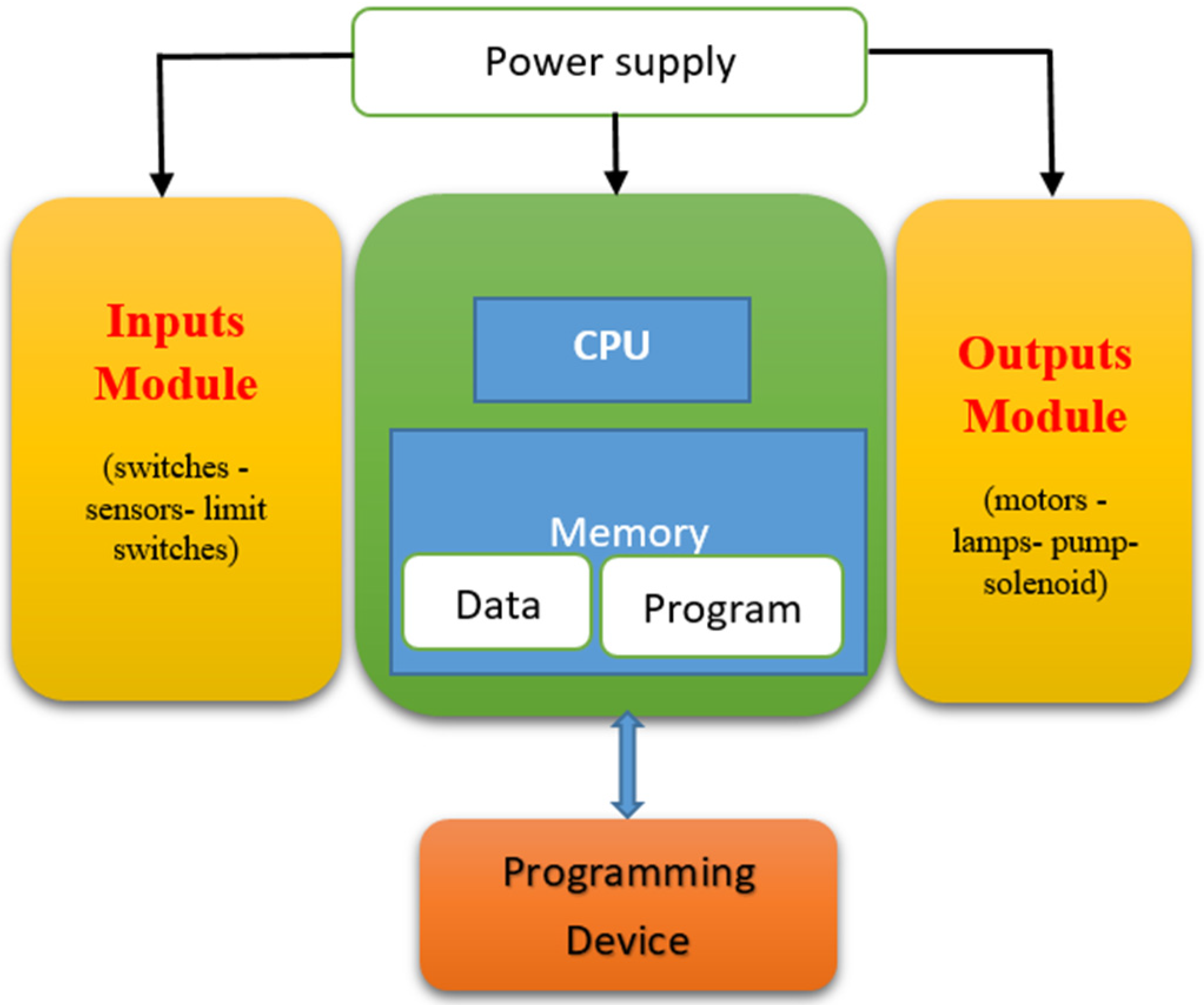


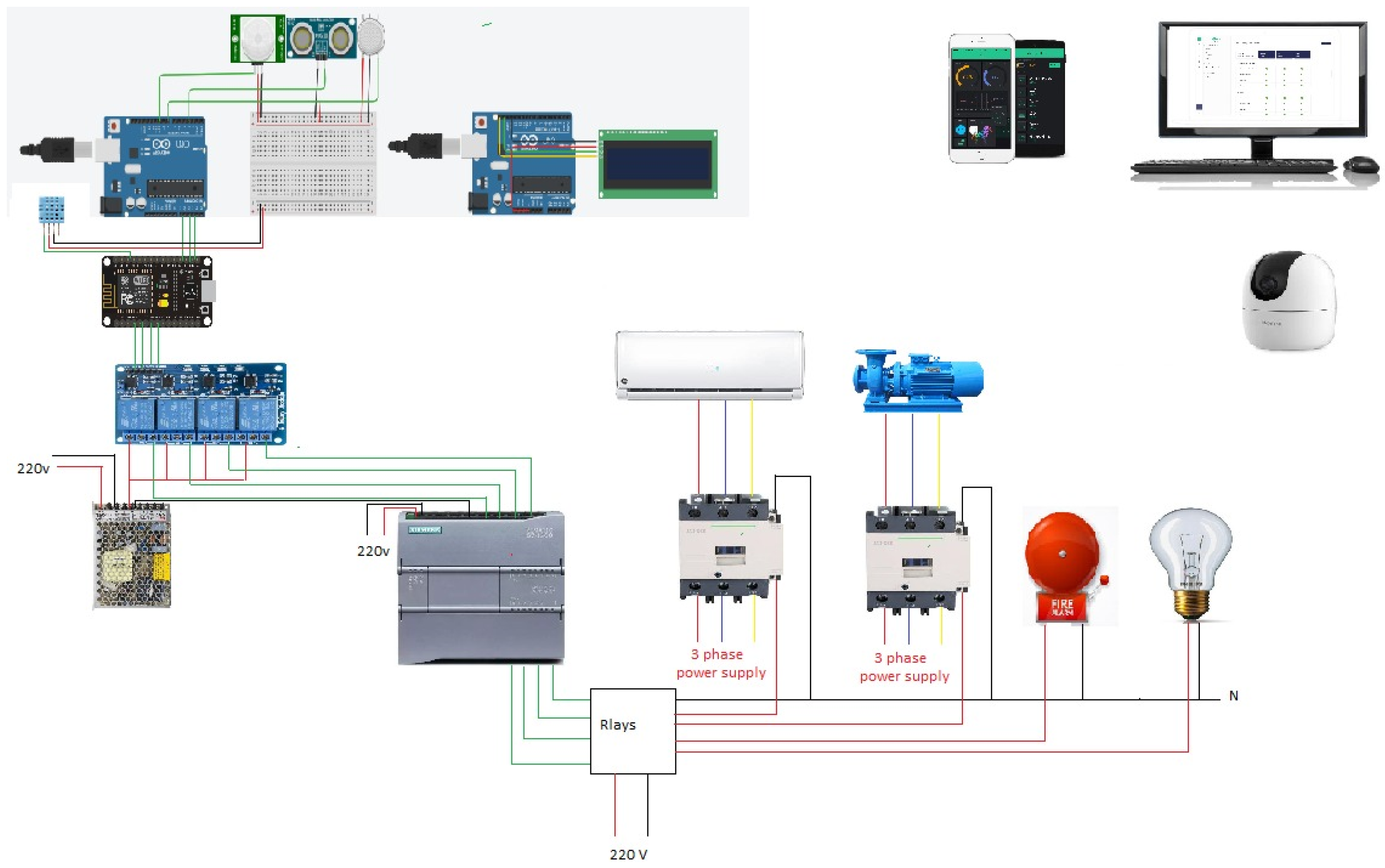
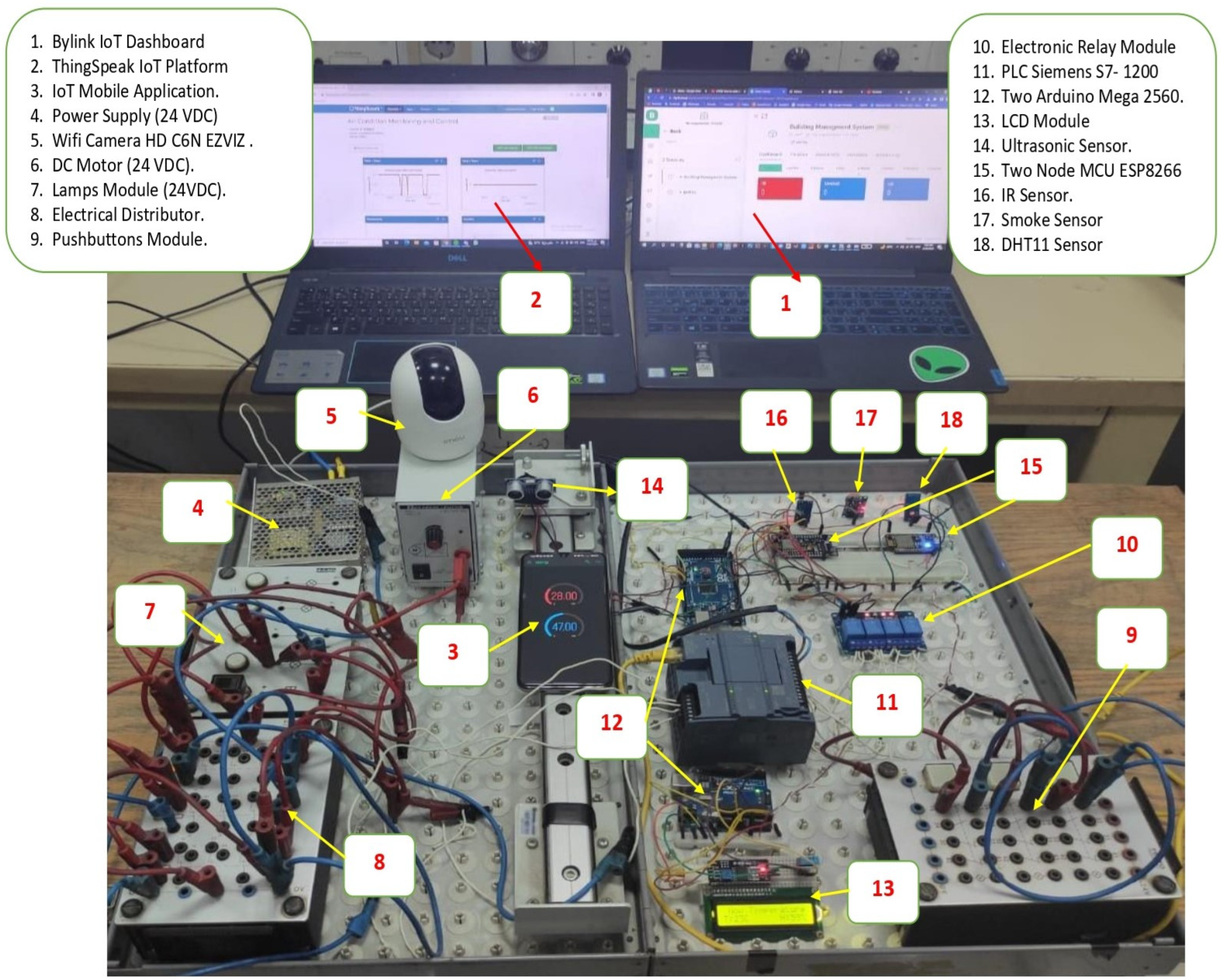
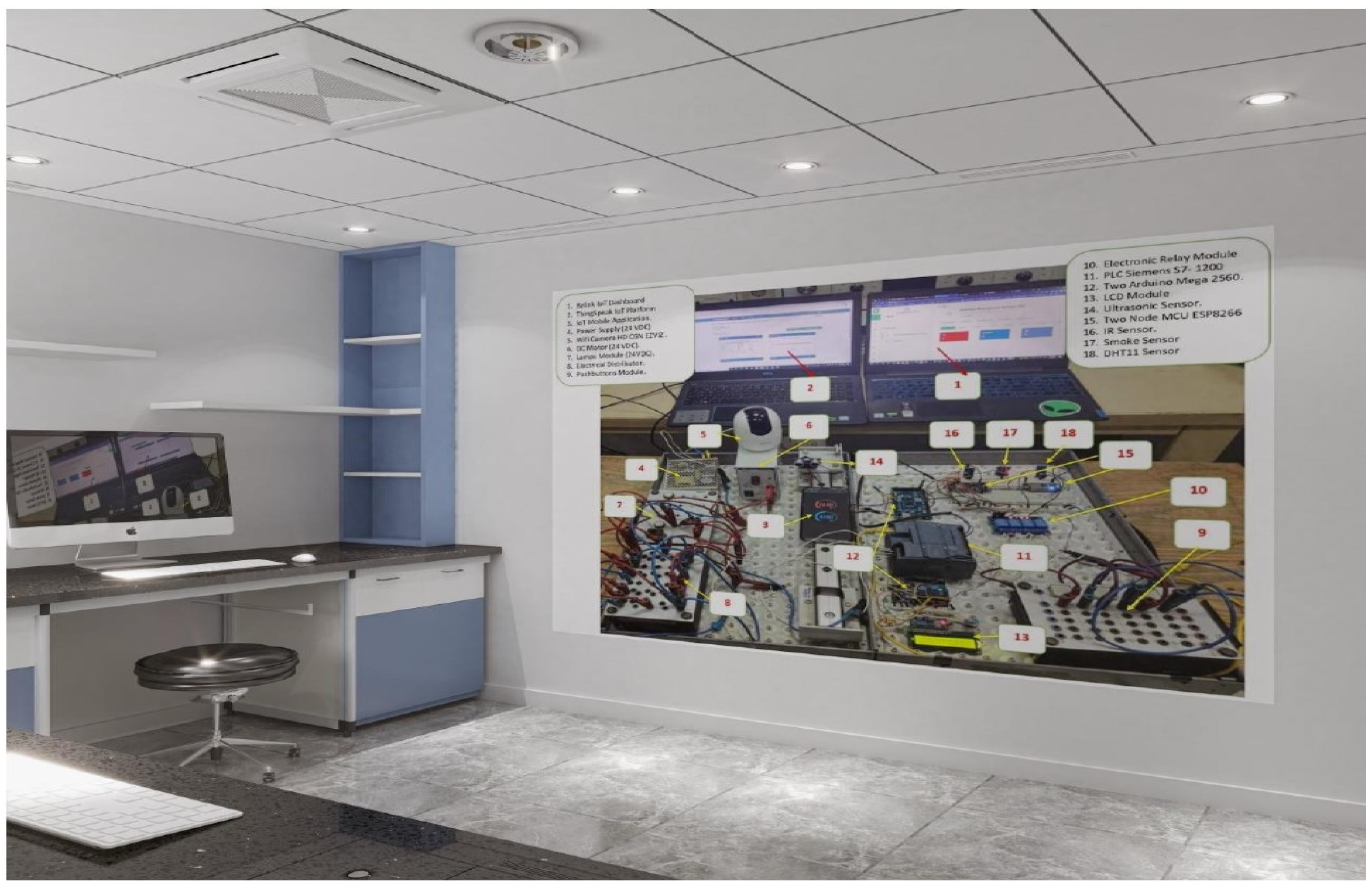



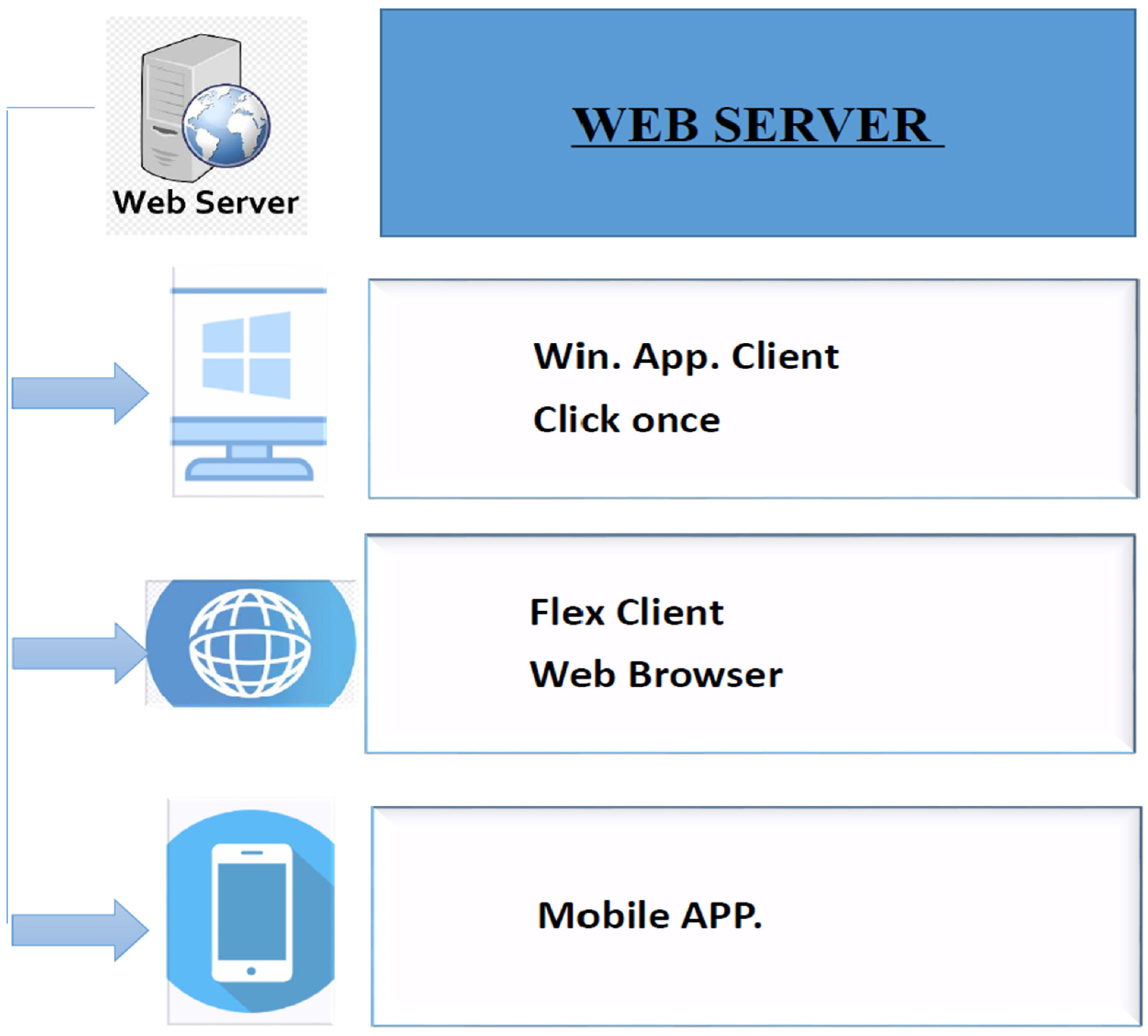


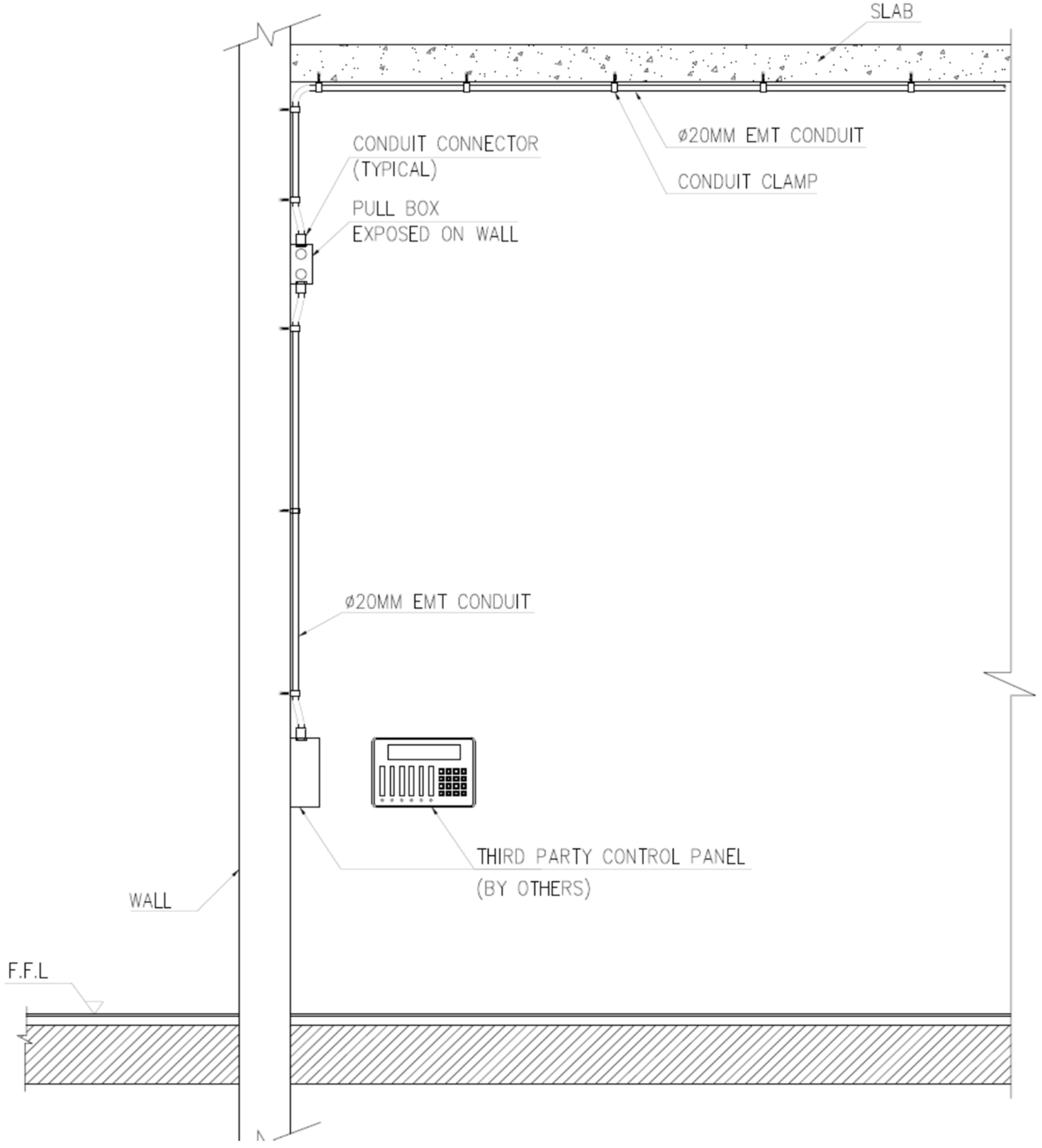
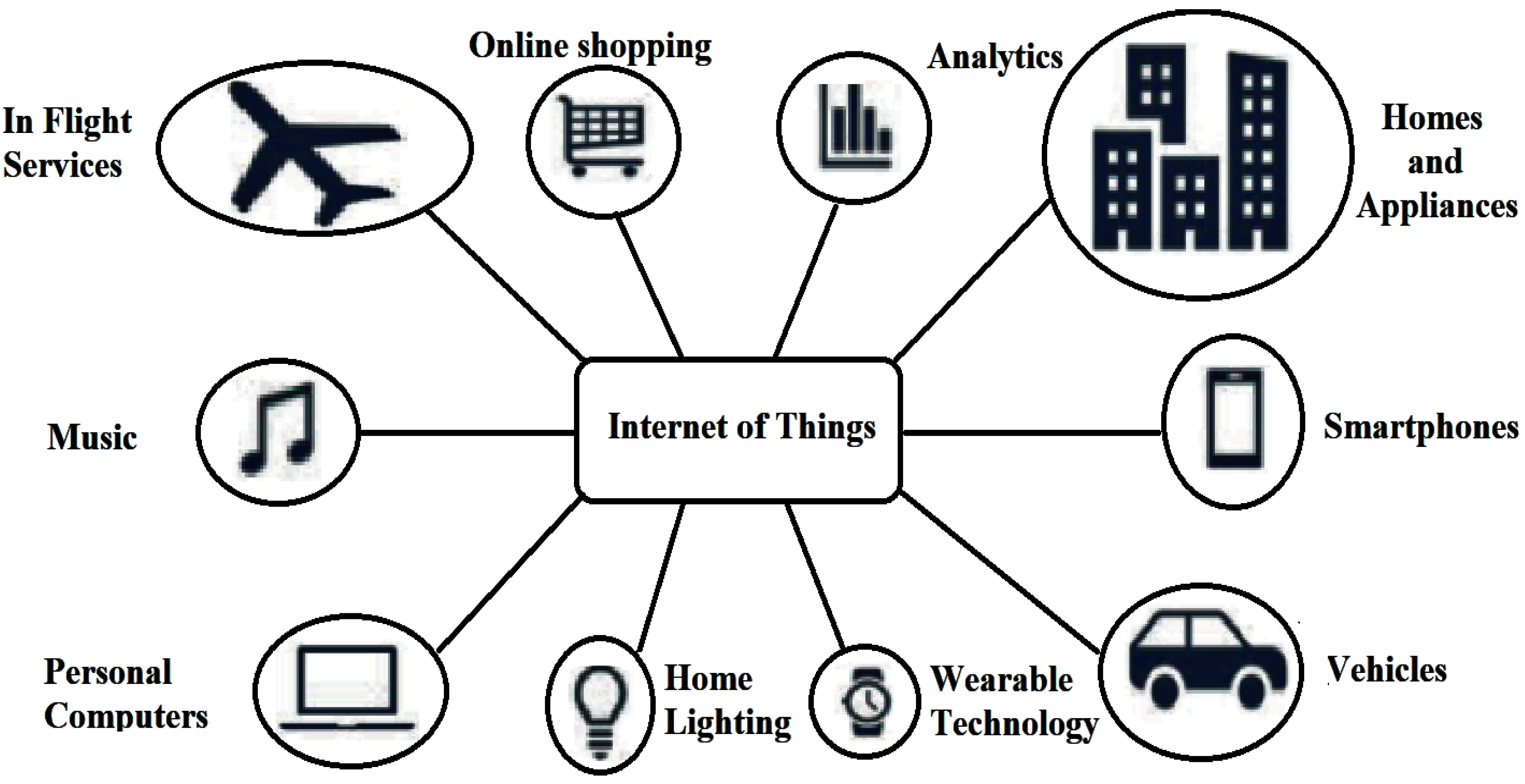
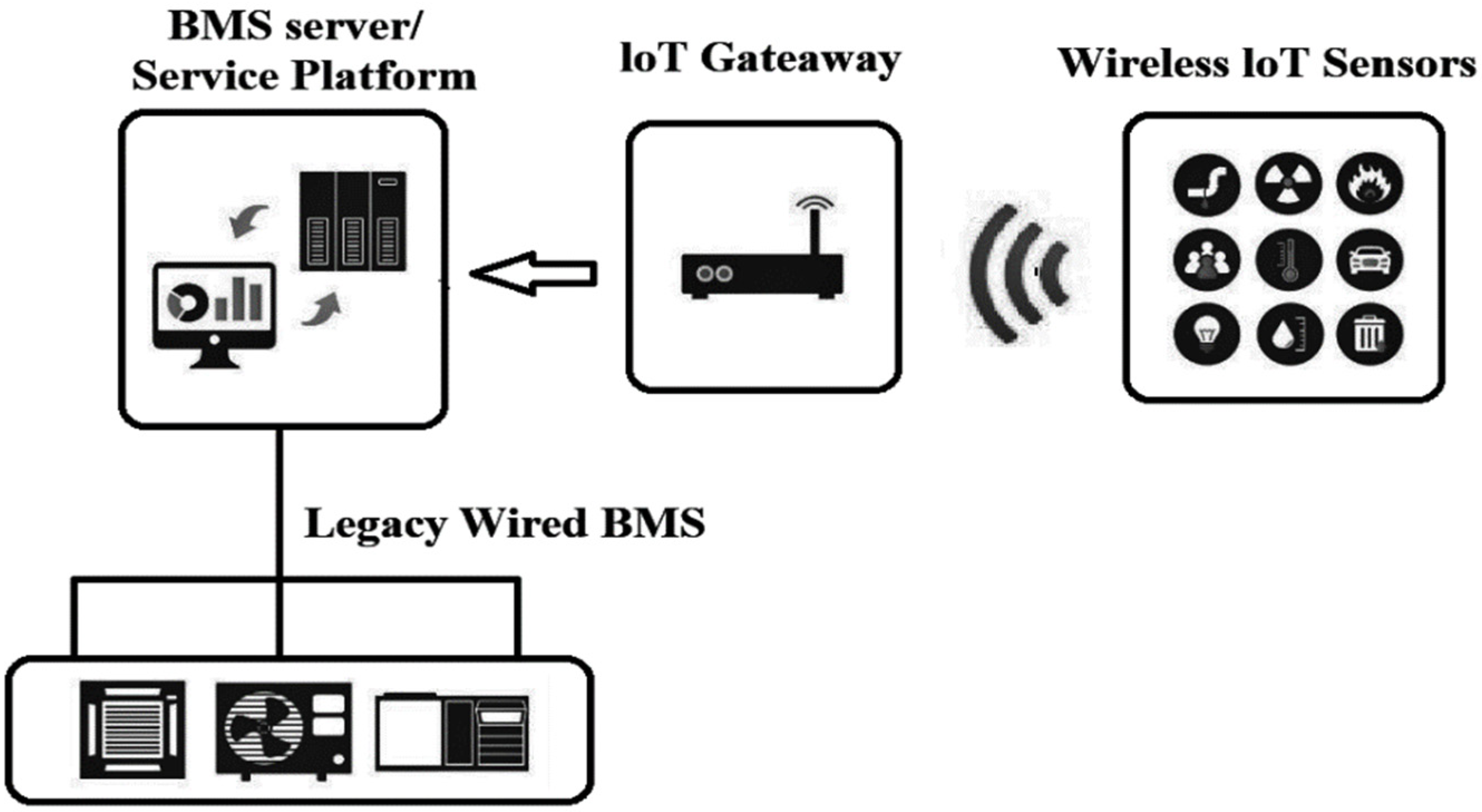
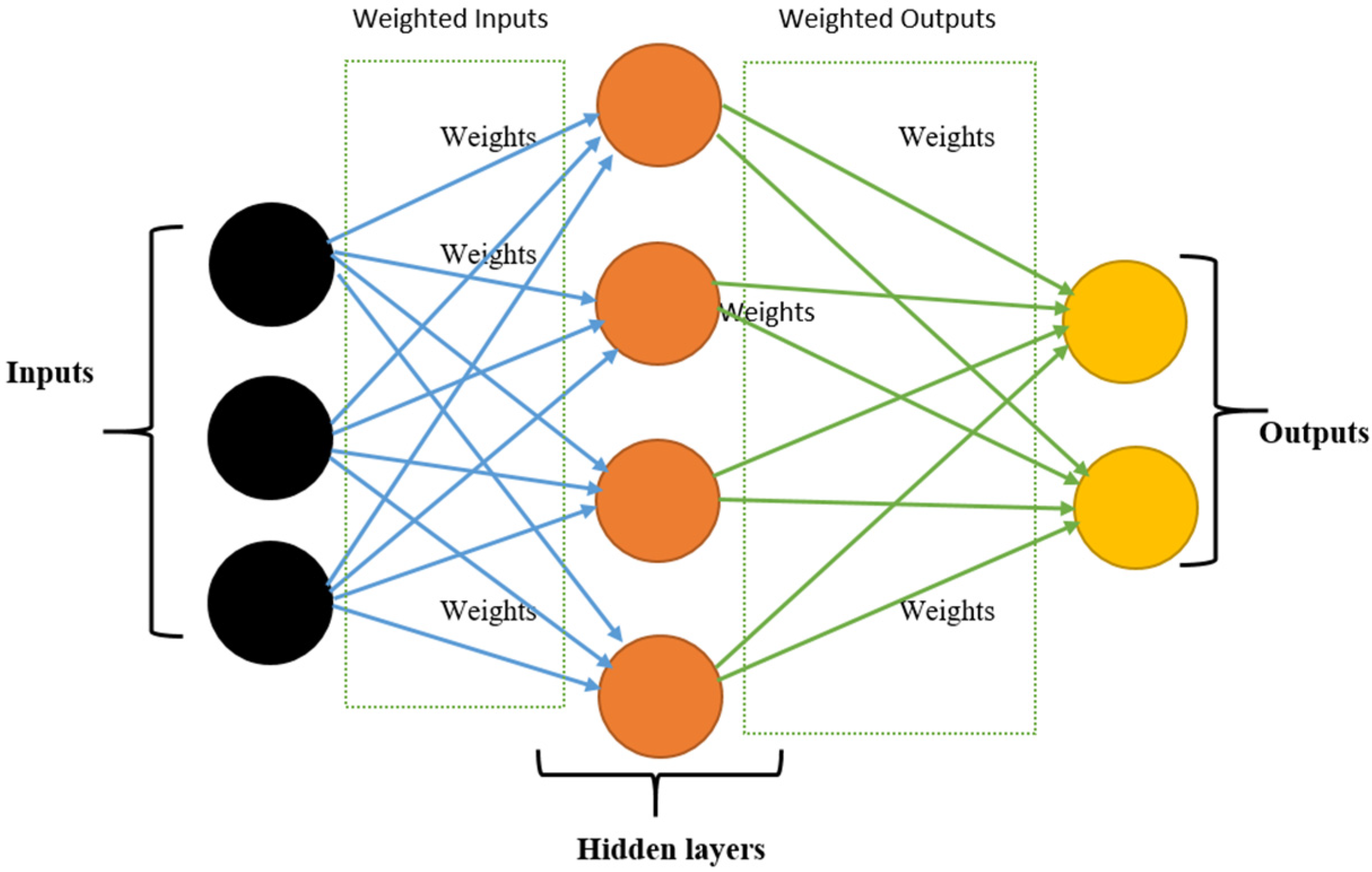


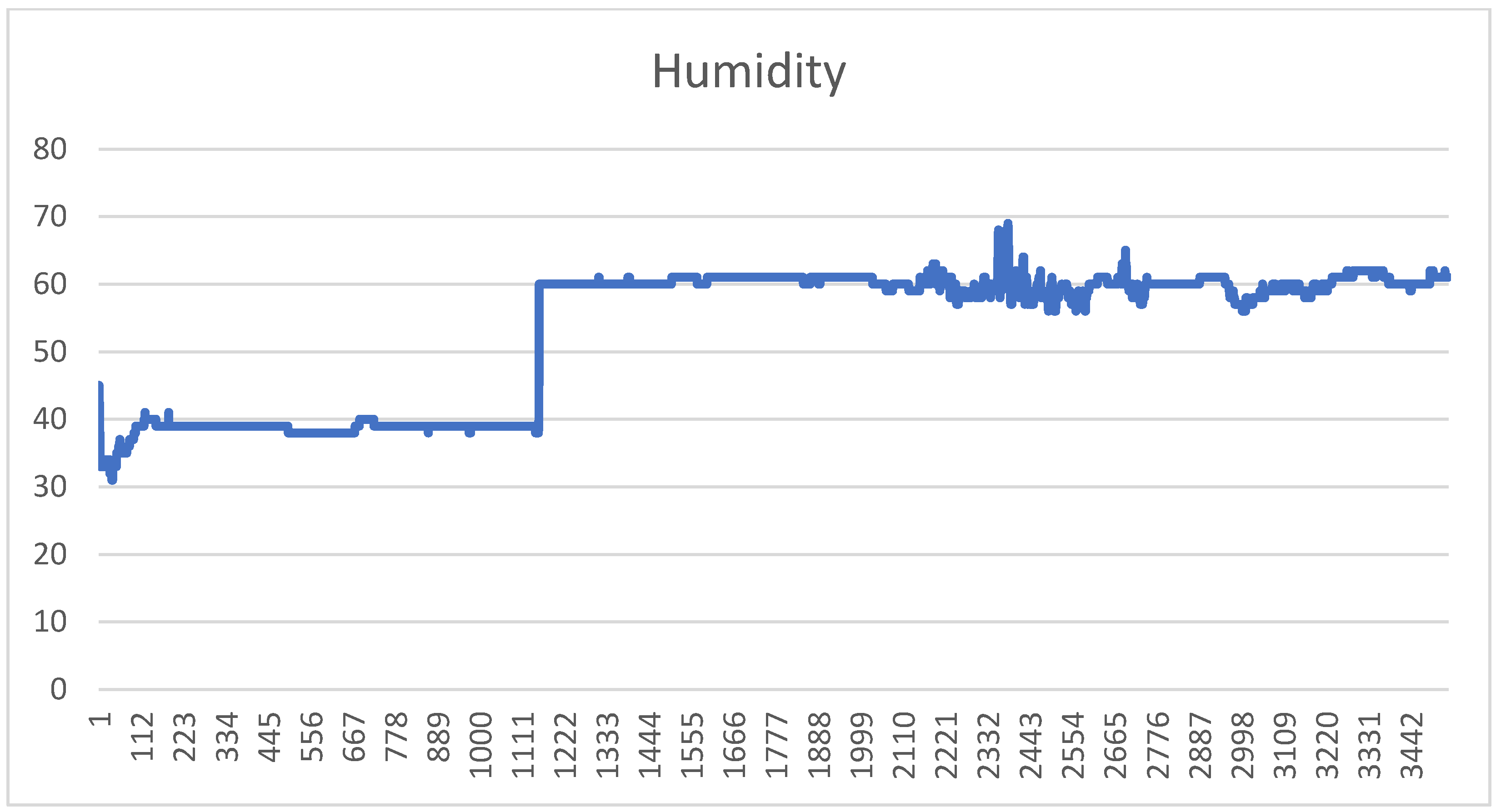

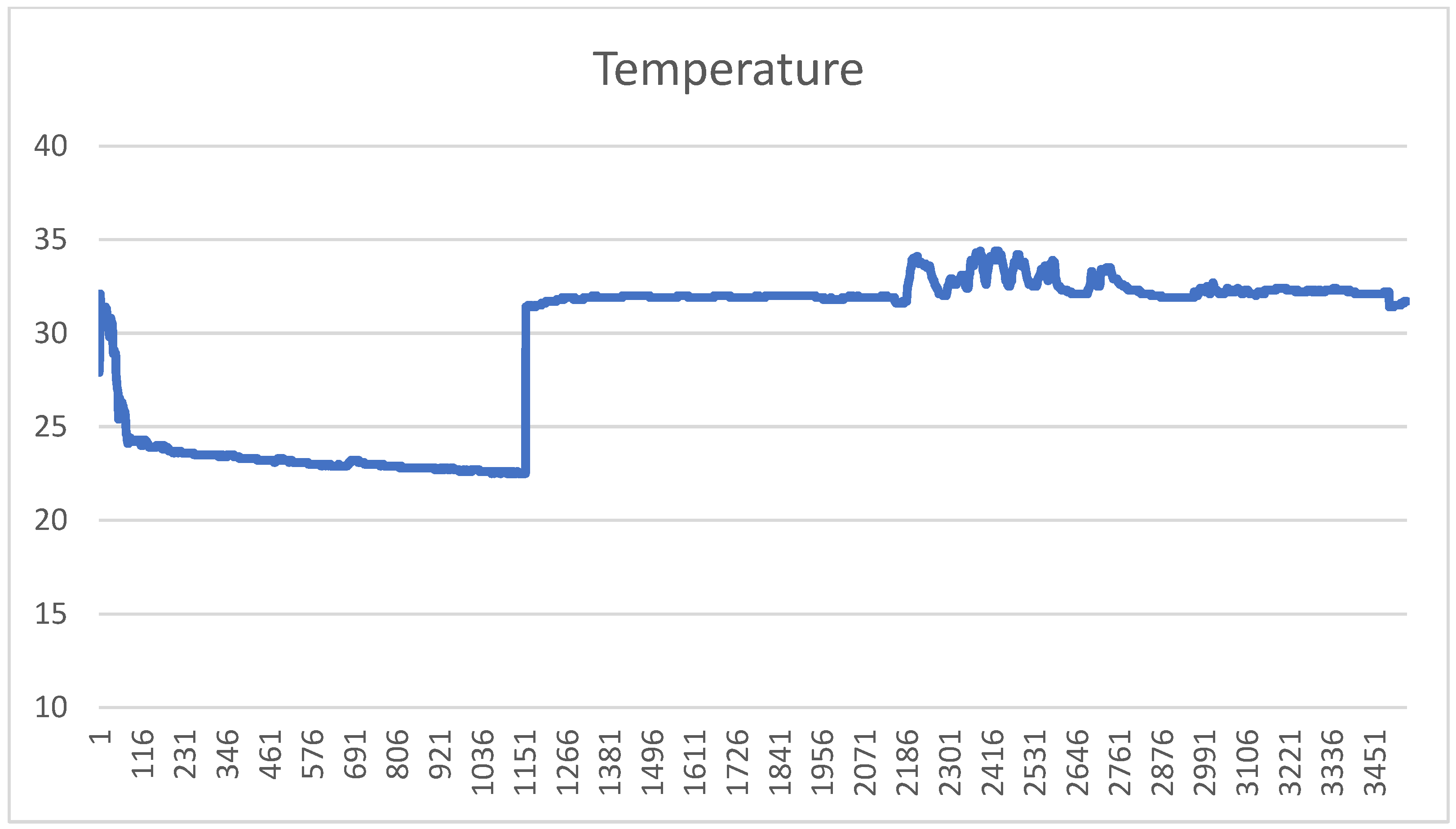




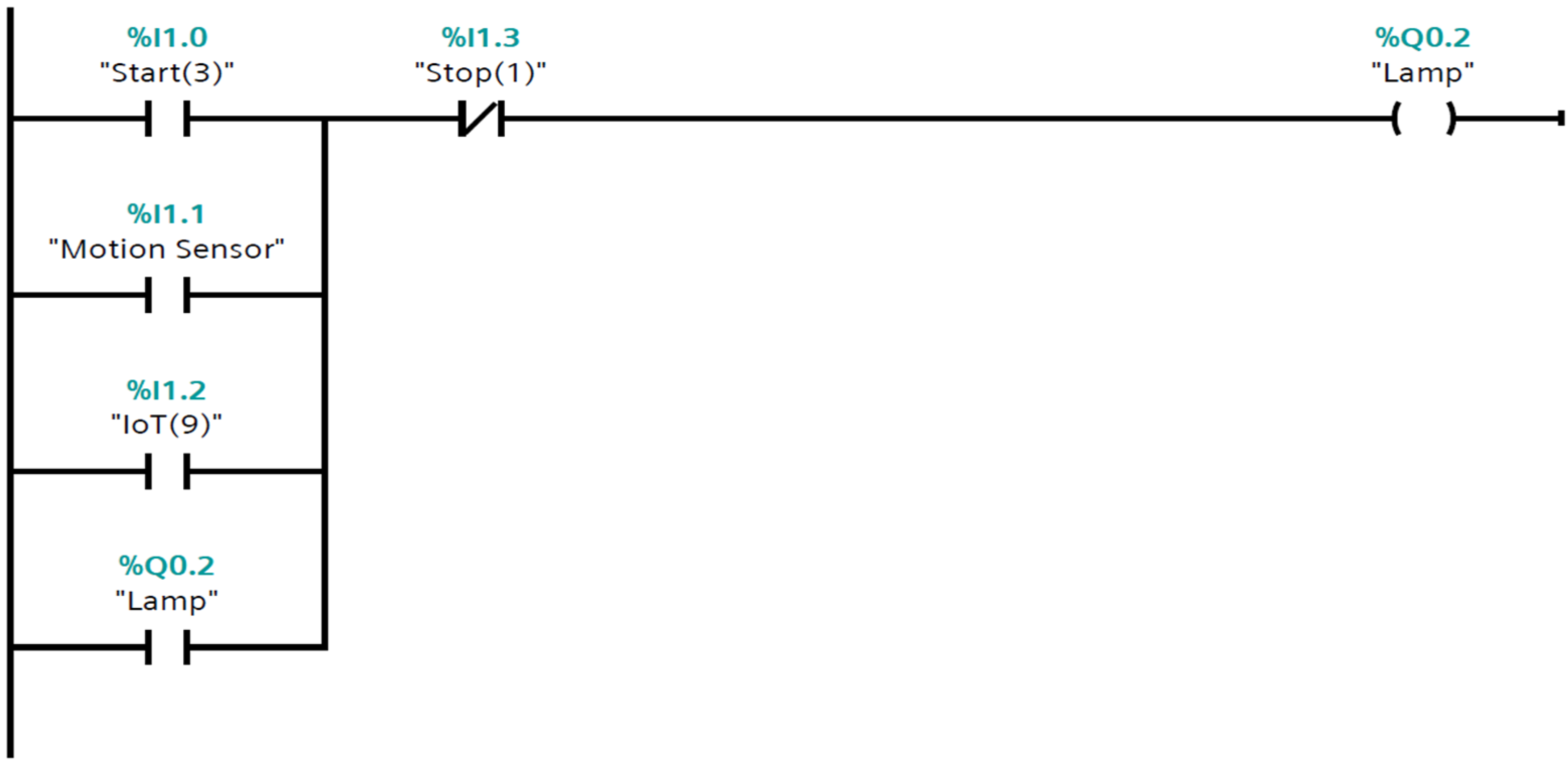




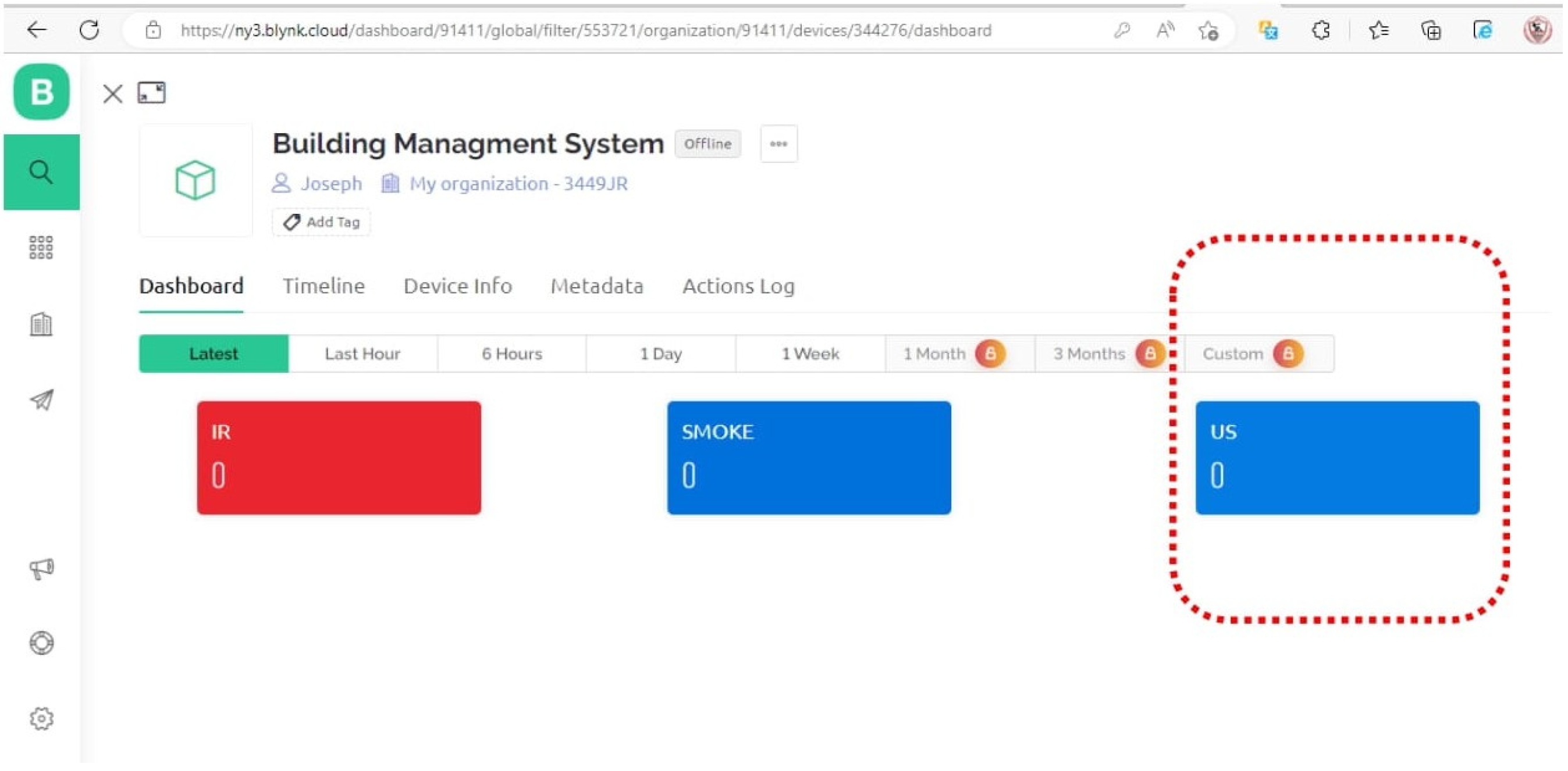
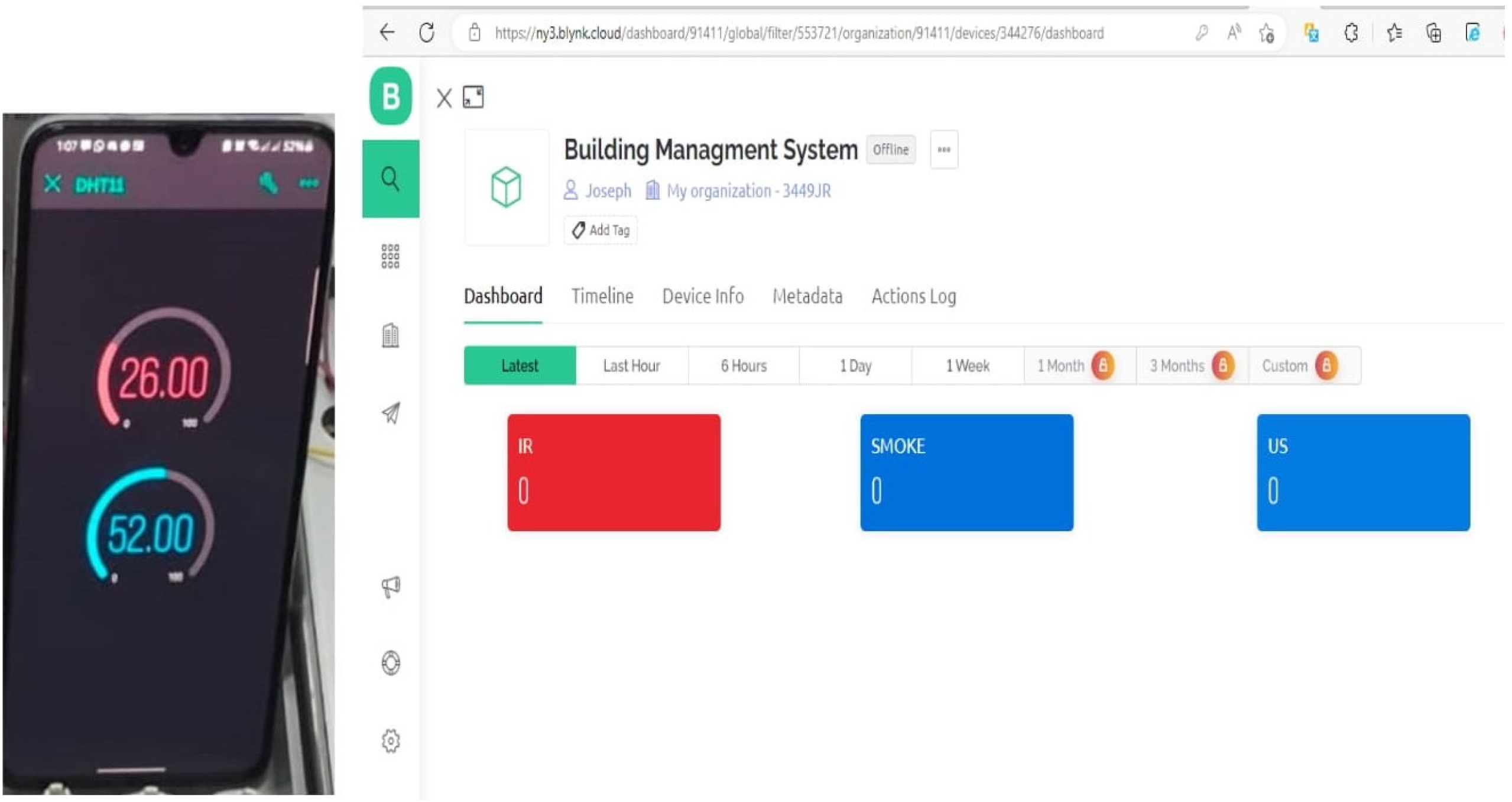
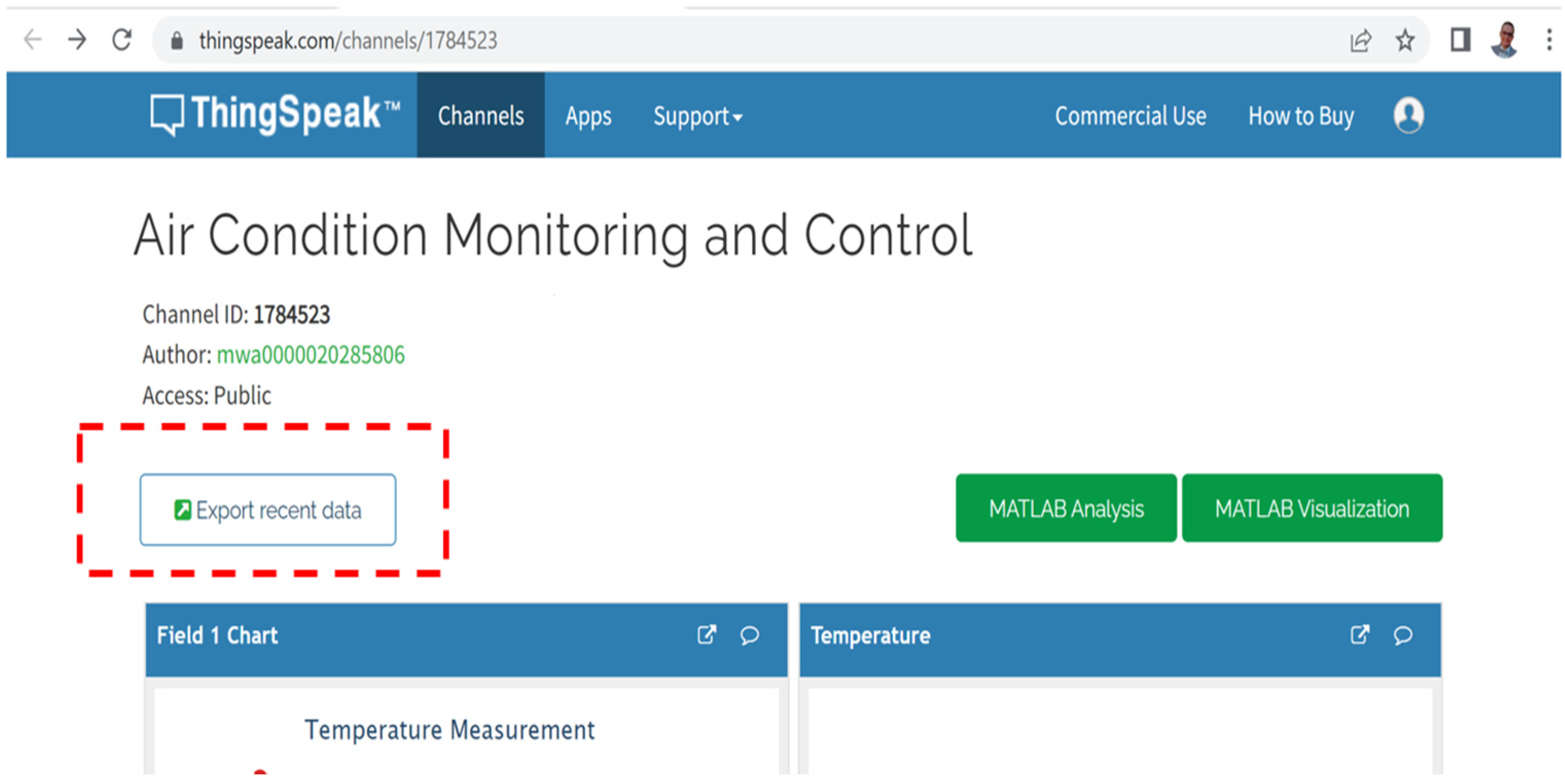
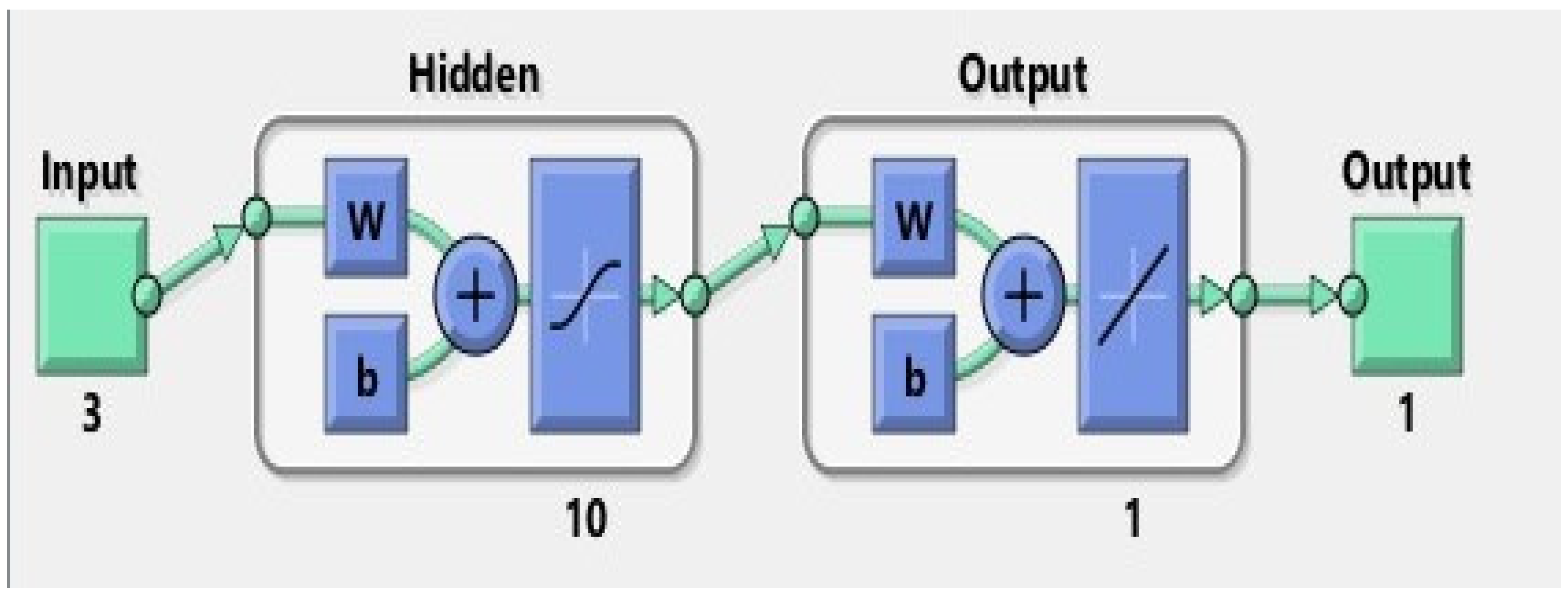
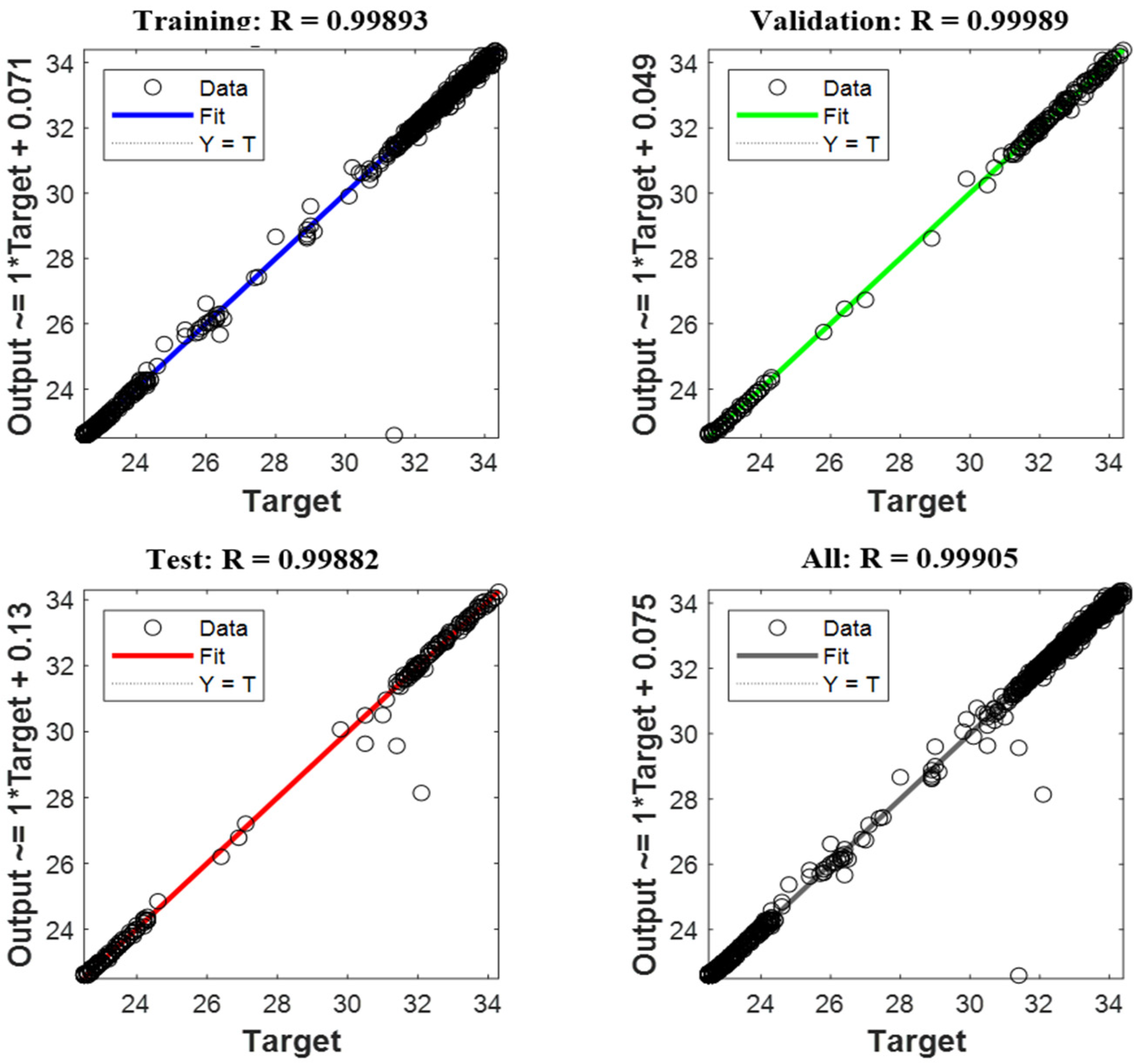
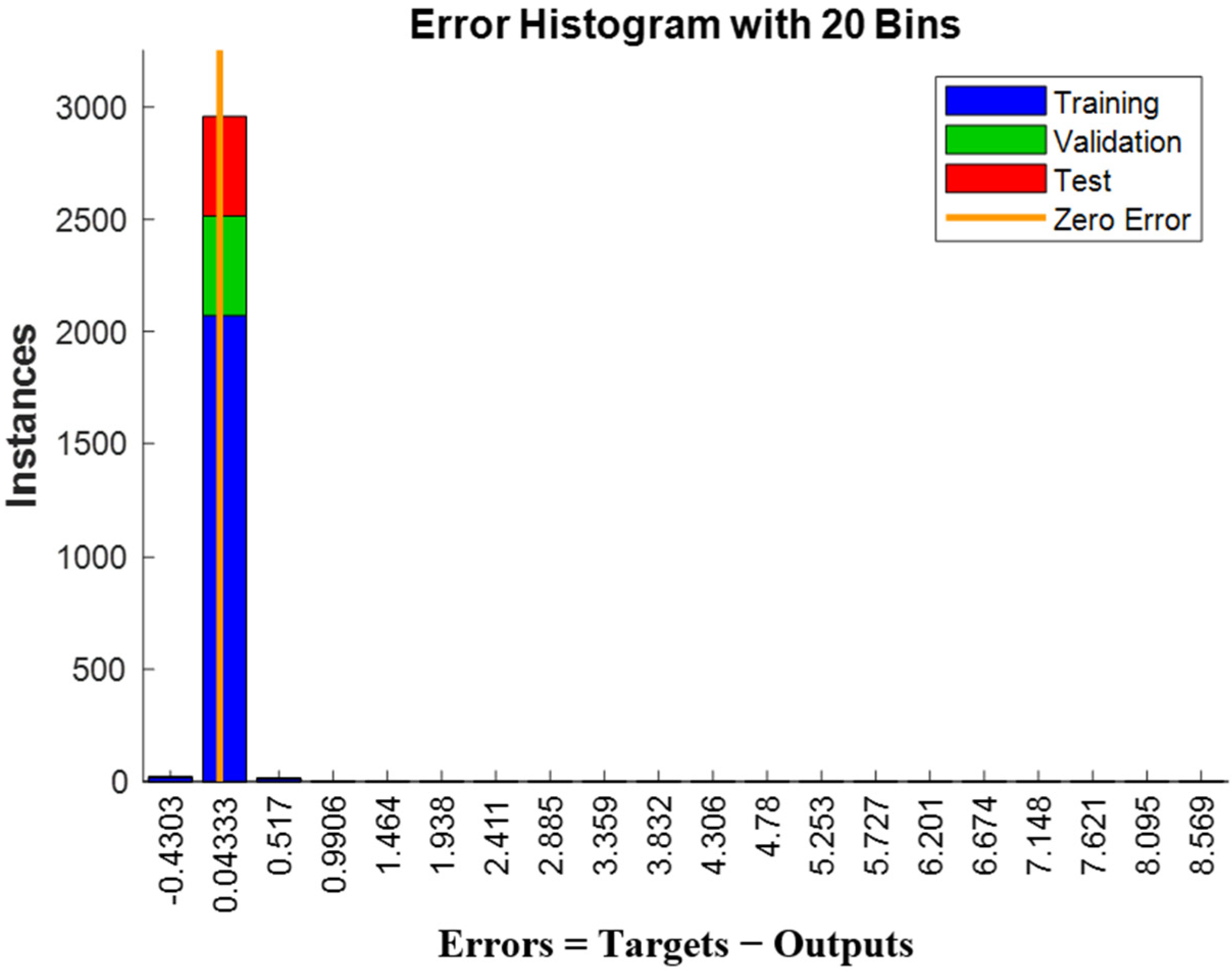
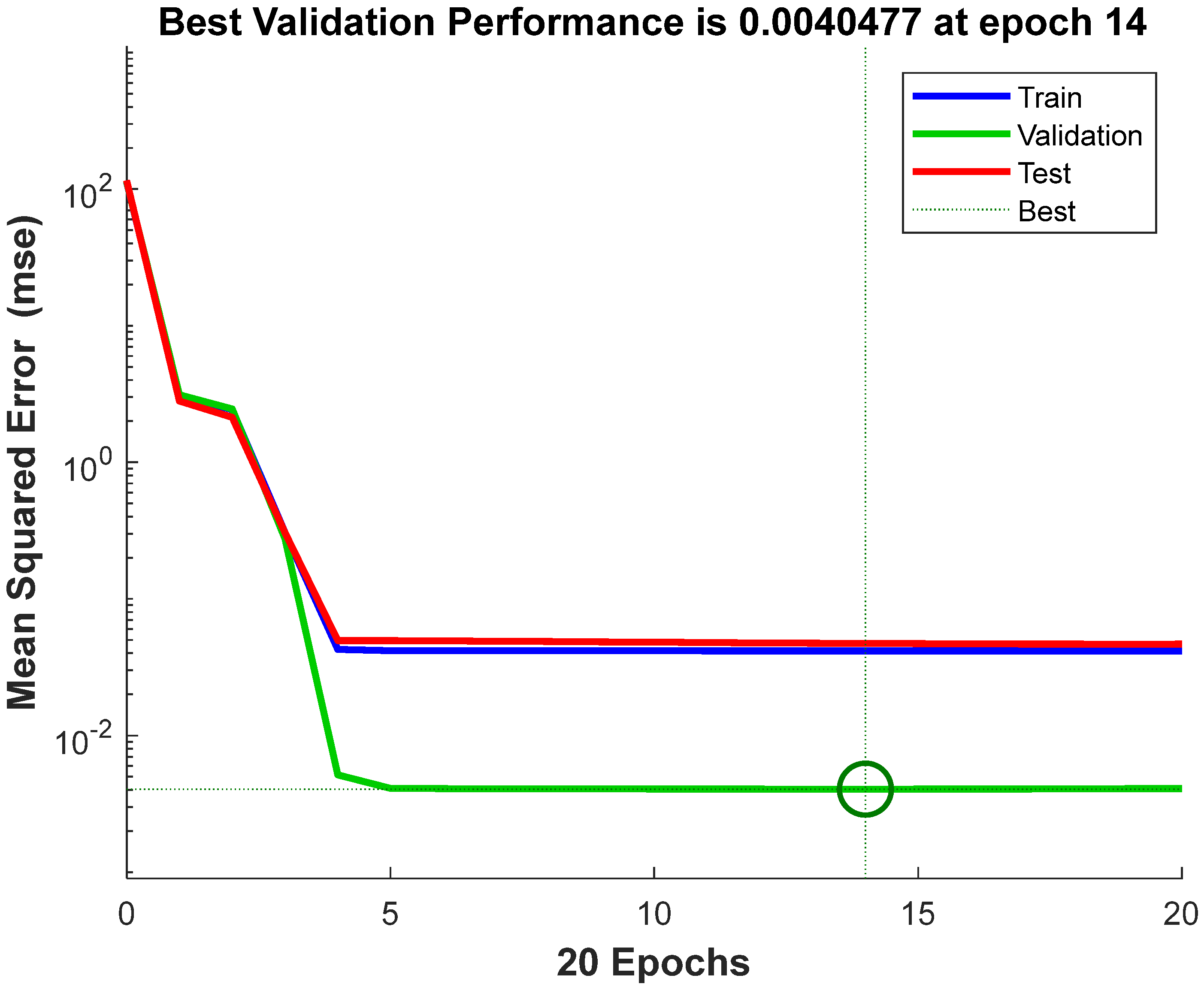
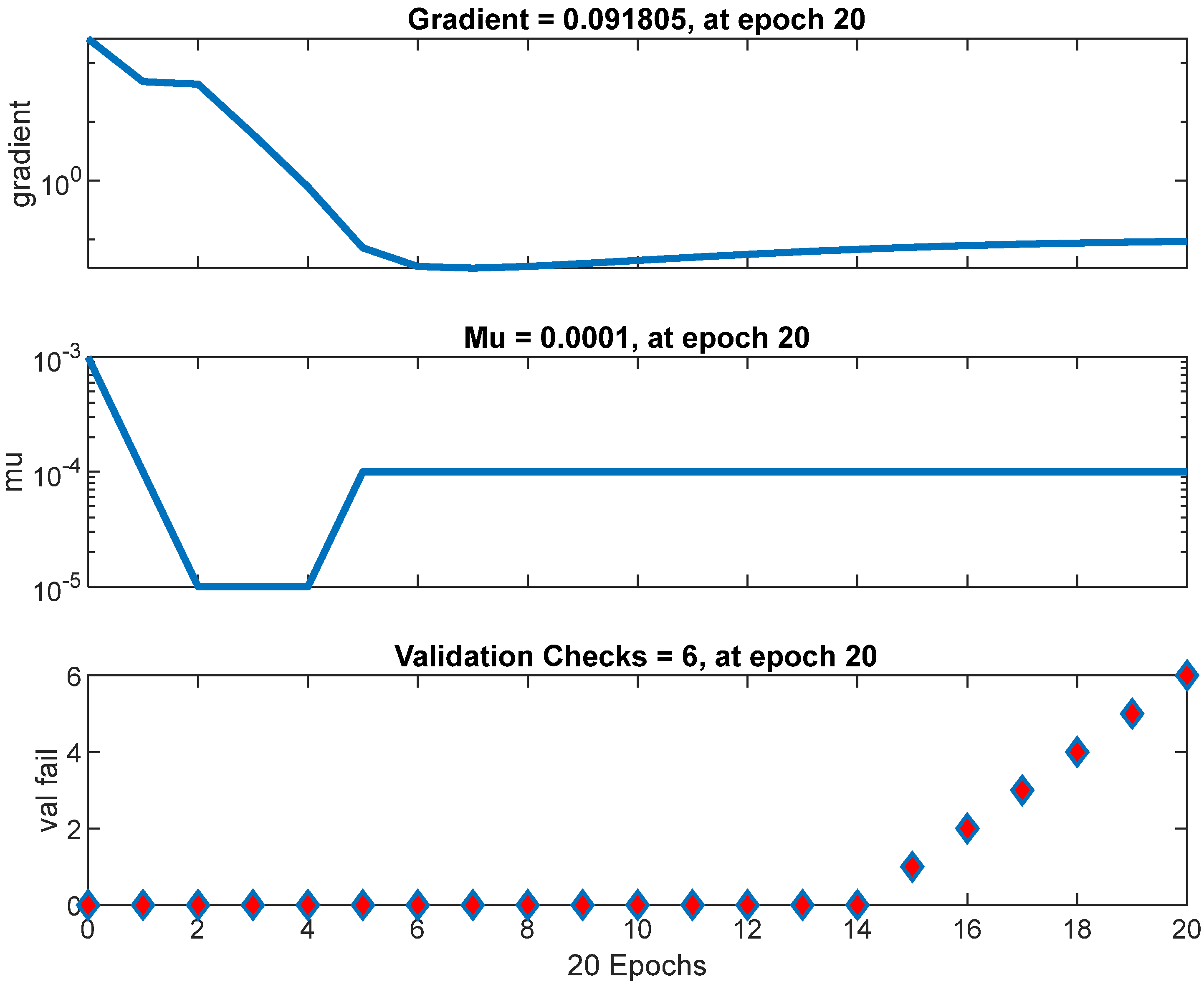
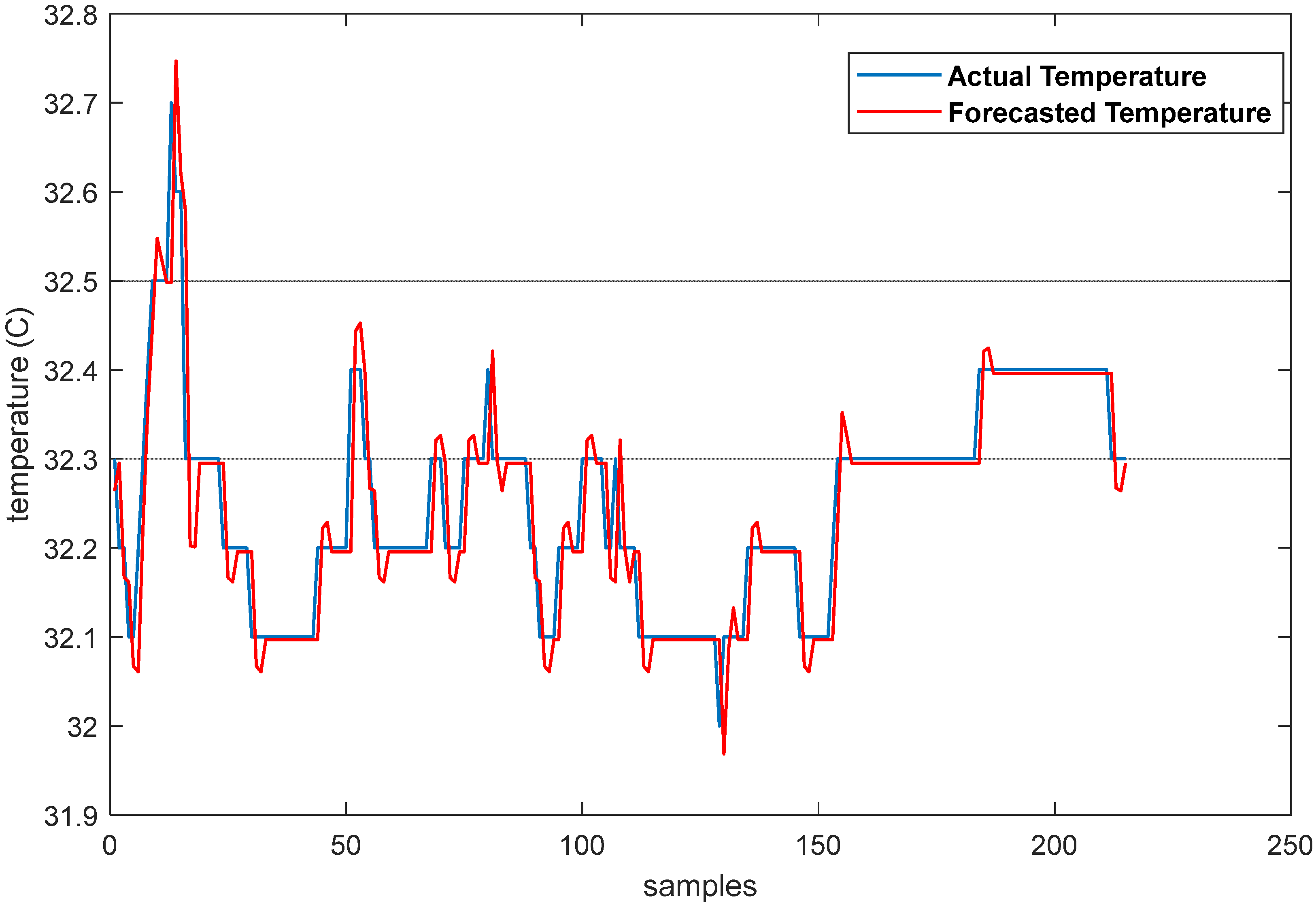
| Samples | MSE | R | |
|---|---|---|---|
| Training | 2100 | 0.0416 | 0.998 |
| Validation | 450 | 0.004 | 0.999 |
| Testing | 450 | 0.047 | 0.998 |
Disclaimer/Publisher’s Note: The statements, opinions and data contained in all publications are solely those of the individual author(s) and contributor(s) and not of MDPI and/or the editor(s). MDPI and/or the editor(s) disclaim responsibility for any injury to people or property resulting from any ideas, methods, instructions or products referred to in the content. |
© 2023 by the authors. Licensee MDPI, Basel, Switzerland. This article is an open access article distributed under the terms and conditions of the Creative Commons Attribution (CC BY) license (https://creativecommons.org/licenses/by/4.0/).
Share and Cite
Essa, M.E.-S.M.; El-shafeey, A.M.; Omar, A.H.; Fathi, A.E.; Maref, A.S.A.E.; Lotfy, J.V.W.; El-Sayed, M.S. Reliable Integration of Neural Network and Internet of Things for Forecasting, Controlling, and Monitoring of Experimental Building Management System. Sustainability 2023, 15, 2168. https://doi.org/10.3390/su15032168
Essa ME-SM, El-shafeey AM, Omar AH, Fathi AE, Maref ASAE, Lotfy JVW, El-Sayed MS. Reliable Integration of Neural Network and Internet of Things for Forecasting, Controlling, and Monitoring of Experimental Building Management System. Sustainability. 2023; 15(3):2168. https://doi.org/10.3390/su15032168
Chicago/Turabian StyleEssa, Mohamed El-Sayed M., Ahmed M. El-shafeey, Amna Hassan Omar, Adel Essa Fathi, Ahmed Sabry Abo El Maref, Joseph Victor W. Lotfy, and Mohamed Saleh El-Sayed. 2023. "Reliable Integration of Neural Network and Internet of Things for Forecasting, Controlling, and Monitoring of Experimental Building Management System" Sustainability 15, no. 3: 2168. https://doi.org/10.3390/su15032168
APA StyleEssa, M. E.-S. M., El-shafeey, A. M., Omar, A. H., Fathi, A. E., Maref, A. S. A. E., Lotfy, J. V. W., & El-Sayed, M. S. (2023). Reliable Integration of Neural Network and Internet of Things for Forecasting, Controlling, and Monitoring of Experimental Building Management System. Sustainability, 15(3), 2168. https://doi.org/10.3390/su15032168









